volcano
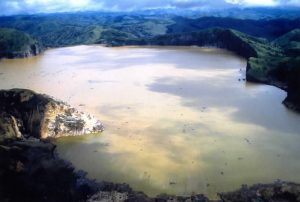 We have all heard about volcanic eruptions, seen photos or video of one, or maybe even seen one in person. They are an event that makes it hard to take your eyes off of the scene. There are volcanos that erupt often, and there are those that haven’t erupted in hundreds of years. And, there are volcanos that erupt under the ocean. But…there is a rare type of eruption, that is, in fact so rare that it has only been observed twice, although it may have happened elsewhere. It is called a Limnic Eruption.
We have all heard about volcanic eruptions, seen photos or video of one, or maybe even seen one in person. They are an event that makes it hard to take your eyes off of the scene. There are volcanos that erupt often, and there are those that haven’t erupted in hundreds of years. And, there are volcanos that erupt under the ocean. But…there is a rare type of eruption, that is, in fact so rare that it has only been observed twice, although it may have happened elsewhere. It is called a Limnic Eruption.
A limnic eruption, also called a lake overturn, is a rare type of natural disaster in which dissolved carbon dioxide (CO2) gas suddenly erupts from deep lake waters. The eruption forms a gas cloud that can suffocate wildlife, livestock, and humans. It can also cause tsunamis in the lake as the rising CO2 displaces the water. Scientists believe earthquakes, volcanic activity, or explosions can be a trigger for such an explosion. Lakes in which limnic activity occurs are known as limnically active lakes or exploding lakes. Some clues as to limnically active lakes include: CO2 saturated incoming water, a cool lake bottom indicating an absence of direct volcanic interaction with lake waters, an upper and lower thermal layer with differing CO2 saturations, and proximity to areas with volcanic activity, all of which are possible indicators of a limnic lake.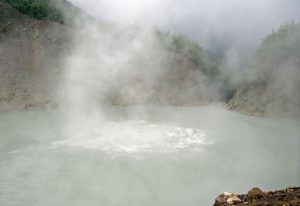
After a Limnic explosion the water left in the lake is filled with debris and massive amounts of dissolved CO2. To date, this phenomenon has been observed only twice. The first was in Cameroon at Lake Monoun in 1984, causing the asphyxiation and death of 38 people living nearby. A second, deadlier eruption happened at neighboring Lake Nyos in 1986, this time releasing over 80 million cubic meters of CO2 and killing around 1,700 people and 3,500 livestock, again by asphyxiation. When the explosion occurred in Lake Nyos, a geyser of water shot out of the lake reaching a height of 300 feet. A small tsunami rushed over the land, followed by a carbon dioxide blast that asphyxiated people up to 15 miles away. Scientists believe limnic explosions are caused by pockets of magma under lakes, which leak and cause carbonic acid to form. In an effort to prevent future explosions, degassing tubes were installed in Lake Nyos to allow the gas to leak at a safe rates.
A third lake, Lake Kivu, on the border between the Democratic Republic of the Congo and Rwanda, also contains massive amounts of dissolved CO2, and it is believed that Limnic eruptions have occurred there too. 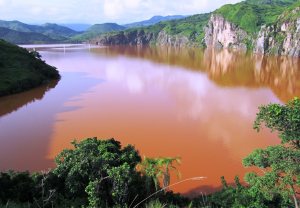 Sample sediments from the lake were taken by professor Robert Hecky from the University of Michigan, which showed that an event caused living creatures in the lake to go extinct approximately every thousand years, and caused nearby vegetation to be swept back into the lake. Limnic eruptions can be measured on a scale using the concentration of CO2 in the surrounding area. Due to the nature of the event, it is hard to determine if limnic eruptions have happened elsewhere. The Messel pit fossil deposits of Messel, Germany, also show evidence of a limnic eruption there. Among the victims of that eruption are perfectly preserved insects, frogs, turtles, crocodiles, birds, anteaters, insectivores, early primates and paleotheres.
Sample sediments from the lake were taken by professor Robert Hecky from the University of Michigan, which showed that an event caused living creatures in the lake to go extinct approximately every thousand years, and caused nearby vegetation to be swept back into the lake. Limnic eruptions can be measured on a scale using the concentration of CO2 in the surrounding area. Due to the nature of the event, it is hard to determine if limnic eruptions have happened elsewhere. The Messel pit fossil deposits of Messel, Germany, also show evidence of a limnic eruption there. Among the victims of that eruption are perfectly preserved insects, frogs, turtles, crocodiles, birds, anteaters, insectivores, early primates and paleotheres.
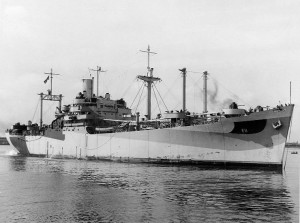 Any time ammunition, explosives, and bombs are being stored in a smaller space, and handled by multiple people, there is a possibility of disaster. The USS Mount Hood was the lead ship of her class of ammunition ships for the United States Navy in World War II. Her life was short lived. The North Carolina Shipbuilding Company began work on the ship on September 28, 1943, and the intended name of the ship was SS Marco Polo. It was first launched on November 28, 1943, and aquired by the Navy on January 28, 1944. It was commissioned the USS Mount Hood on July 1, 1944. The ship was named after Mount Hood, the volcano in the Cascade Range in Oregon.
Any time ammunition, explosives, and bombs are being stored in a smaller space, and handled by multiple people, there is a possibility of disaster. The USS Mount Hood was the lead ship of her class of ammunition ships for the United States Navy in World War II. Her life was short lived. The North Carolina Shipbuilding Company began work on the ship on September 28, 1943, and the intended name of the ship was SS Marco Polo. It was first launched on November 28, 1943, and aquired by the Navy on January 28, 1944. It was commissioned the USS Mount Hood on July 1, 1944. The ship was named after Mount Hood, the volcano in the Cascade Range in Oregon.
Following a short fitting out and shakedown period in the Chesapeake Bay area, the USS Mount Hood reported for duty to ComServFor, Atlantic Fleet on August 5, 1944. She was assigned to carry cargo to the Pacific, and she pulled in to Norfolk, where her holds were loaded. The she was transfered to the Panama Canal as part of 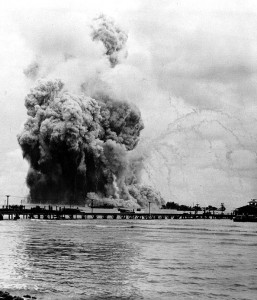 Task Group 29.6. She finally ended up Seeadler Harbor at Manus Island of the Admiralty Islands on September 22, 1944. There she was assigned to ComSoWesPac. The ship was to be dispensing ammunition and explosives to ships preparing for the Philippine offensive.
Task Group 29.6. She finally ended up Seeadler Harbor at Manus Island of the Admiralty Islands on September 22, 1944. There she was assigned to ComSoWesPac. The ship was to be dispensing ammunition and explosives to ships preparing for the Philippine offensive.
At 8:30am, on November 10, 1944, 17 of USS Mount Hood’s crew members, including Lieutenant Lester H Wallace left the ship to go ashore. At 8:55am, while walking on the beach the men saw a flash and heard two quick explosions. They immediately jumped back in their boat and headed for their ship, only to find that, like volcanoes tend to do, the USS Mount Hood had exploded. There was literally no ship to come back to, and other ships in the area were heavily damaged too. The USS Mount Hood had been anchored in 35 feet of water, and had exploded with an estimated 3,800 tons of ordnance material on board. Mushrooming smoke rose to 7,000 feet, completely obscuring the ship and the surrounding area for approximately 500 yards. It was easy to see where USS Mount Hood had been, because the explosion created a trench in the ocean floor 1,000 feet long, 200 feet wide, and 40 feet deep.The largest remaining piece of the hull was found in the trench and measured about 16 feet by 10 feet. No other remains were found except the fragments which struck the other ships in the area. No human remains were recovered of the 350 men aboard USS Mount Hood or the small boats loading alongside at the time of the explosion.

There were 271 men in surrounding ships that were injured, and 82 of nearby Mindanao’s crew were killed. In all, 22 small boats and landing craft were sunk, destroyed, or damaged beyond repair. The exact cause of USS Mount Hood’s explosion was never determined, but since the possibility of enemy action was remote, it was thought that rough handling of some of the explosives during the loading and unloading process was to blame for the disaster. With no survivors and so little of the ship left, I’m sure that the investigation was an impossible task. I do find it ironic that a ship named after a volcano, ended up exploding, and I find the loss of life to be a very sad thing indeed.
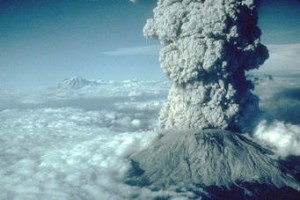 In April of 1993, my sisters, Cheryl Masterson, Alena Stevens, Allyn Hadlock, and I took a trip to the Seattle, Washington area where our sister, Caryl Reed and her family were living at the time. I had not been there before, and so was excited at the prospect. We planned to have dinner at the Space Needle, do some shopping, visit Friday Harbor, and the one I was most looking forward to, Mount Saint Helens. Since the mountain had blown up on May 18, 1980, I had been intrigued. My parents had gone there, but I was married and so didn’t go along. On that trip, because the roads there didn’t open until May, and this was April, the viewing of Mount Saint Helens was not to be, unfortunately. I was disappointed.
In April of 1993, my sisters, Cheryl Masterson, Alena Stevens, Allyn Hadlock, and I took a trip to the Seattle, Washington area where our sister, Caryl Reed and her family were living at the time. I had not been there before, and so was excited at the prospect. We planned to have dinner at the Space Needle, do some shopping, visit Friday Harbor, and the one I was most looking forward to, Mount Saint Helens. Since the mountain had blown up on May 18, 1980, I had been intrigued. My parents had gone there, but I was married and so didn’t go along. On that trip, because the roads there didn’t open until May, and this was April, the viewing of Mount Saint Helens was not to be, unfortunately. I was disappointed.
I will never forget hearing about the coming eruption in the news, on March 15, 1980. When we first heard about it, people were riveted to their televisions, but as time went on, I suspect that people got bored with it. After two months, it got to the point where we all wondered if it was just a false alarm. Then, at 8:32am Pacific Time on May 18, 1980, the mountain blew up…literally. Suddenly, everyone was riveted to the television again. It was just shocking, and since 9-11 had not happened yet, it seemed like the most shocking thing we had ever experienced…in my lifetime anyway. I remember going out to my car and finding ash all over it. I had a hard time believing that a volcano that was over a thousand miles away in Washington state, could dump ash on my 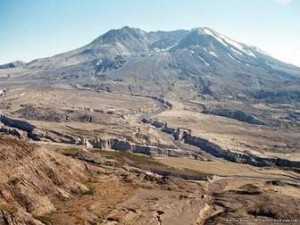 car in Casper, Wyoming. The ash went completely around the globe within a matter of days. Of course, it was nothing like what they had in the area surrounding the mountain.
car in Casper, Wyoming. The ash went completely around the globe within a matter of days. Of course, it was nothing like what they had in the area surrounding the mountain.
When my daughter, Amy Royce and her husband Travis and son, Caalab moved to the Seattle area, and then decided to renew their vows, we decided to make the trip up for the ceremony. I wanted another chance to get to see Mount Saint Helens. My first attempt was thirteen years after the eruption, and that attempt was twenty two years ago. It was time. We had a rather small window of time to go see the mountain, with everything that has been planned at Amy’s house. So, Thursday was the day. Unfortunately, we seem to have picked the worst day of the days we would be here. Nevertheless, we went in the hope of a view of the…for me anyway…elusive Mount Saint Helens. Our grandchildren, Shai and Caalab Royce went with us. They were born well after Mount Saint Helens blew, and really knew very little about it…until today, that is.
Our first stop was to the visitors center, where we looked at the exhibits displayed there and watched a really good movie that told of the events leading up to and including May 18, 1980 and beyond. After we left, I think 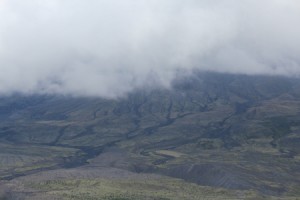 they had a much better idea about the magnitude of the whole event. We drove up to the area where we could finally view the mountain itself, only to find it sitting right there in front of us…completely shrouded in clouds and mist. We could see where the ash had landed and where the water and mud had carved out deep crevasses. We could see where erosion had taken its toll on the area, and where trees had been wiped out, and now rather small ones have grown up in their place. We could see the base of the mountain, and really, almost half way up it, but the now famous space left when the top that is no longer there blew, was still not visible to me. Sadly, I guess some things are simply not meant to be.
they had a much better idea about the magnitude of the whole event. We drove up to the area where we could finally view the mountain itself, only to find it sitting right there in front of us…completely shrouded in clouds and mist. We could see where the ash had landed and where the water and mud had carved out deep crevasses. We could see where erosion had taken its toll on the area, and where trees had been wiped out, and now rather small ones have grown up in their place. We could see the base of the mountain, and really, almost half way up it, but the now famous space left when the top that is no longer there blew, was still not visible to me. Sadly, I guess some things are simply not meant to be.
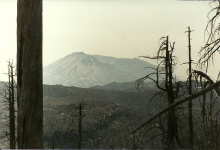 After Mount Saint Helens blew up, and it had been deemed safe for tourism, my parents took a trip to Washington to visit my sister, Caryl and her family who were living in the Seattle area at the time. They decided to take a trip to see Mount St. Helens National Volcanic Monument. I’m not sure how many years after the eruption their trip was, but I do remember them telling me about how totally barren the whole place was. They told us about the buried cars and homes sticking out of the ash…broken and ruined. During that eruption, 57 people lost their lives, as well as countless numbers and species of wildlife. I can’t imagine the way that whole area must have felt to be in…so quiet and empty of life…almost like being on another planet.
After Mount Saint Helens blew up, and it had been deemed safe for tourism, my parents took a trip to Washington to visit my sister, Caryl and her family who were living in the Seattle area at the time. They decided to take a trip to see Mount St. Helens National Volcanic Monument. I’m not sure how many years after the eruption their trip was, but I do remember them telling me about how totally barren the whole place was. They told us about the buried cars and homes sticking out of the ash…broken and ruined. During that eruption, 57 people lost their lives, as well as countless numbers and species of wildlife. I can’t imagine the way that whole area must have felt to be in…so quiet and empty of life…almost like being on another planet.
Yes, it would be a trip of a lifetime…to be able to see an area devastated by a volcano  eruption. It is such a powerful act of nature, and yet, behind it all is such a great loss of life and destruction of such beautiful land, and in this case, even a loss of the beautiful mountain top, now forever changed. So many trees were destroyed, literally blown over and burned in minutes. It is so strange to think that one minute the area was filled with wildlife, trees, and flowers, not to mention people…and the next minute it was all gone. Yes, they knew it was coming, but I’m sure many people truly didn’t believe it would happen, or at least that it would not be as bad as it was. I think that if they could have known what was coming, they would have left the area, but their minds couldn’t wrap themselves around that reality…in fact I don’t think most of the nation expected the eruption to be what it was. I know I was shocked by how devastating it was.
eruption. It is such a powerful act of nature, and yet, behind it all is such a great loss of life and destruction of such beautiful land, and in this case, even a loss of the beautiful mountain top, now forever changed. So many trees were destroyed, literally blown over and burned in minutes. It is so strange to think that one minute the area was filled with wildlife, trees, and flowers, not to mention people…and the next minute it was all gone. Yes, they knew it was coming, but I’m sure many people truly didn’t believe it would happen, or at least that it would not be as bad as it was. I think that if they could have known what was coming, they would have left the area, but their minds couldn’t wrap themselves around that reality…in fact I don’t think most of the nation expected the eruption to be what it was. I know I was shocked by how devastating it was.
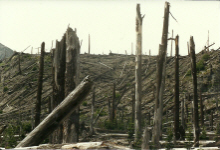
It has been over 32 years since that shocking day in our nation’s history. When I came across the pictures of my parents’ trip through the area, I began to wonder what the area looks like now. It would seem that the area is slow to return to life, but then I suppose that ash makes poor soil for many things to grow in. Weeds might do ok there, but trees and grass…maybe not so much. I don’t know how my parents or my sister, Caryl and her family felt about the area, but their pictures told the story of a disaster of epic proportions.

